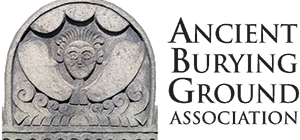Beginning around 1730, death’s heads became more “human” in appearance, more sophisticated in design and execution. The fearsome expression gradually softened into a sober, serene, even smiling one. The bat wings morphed into celestial, often upswept ones. These “angel’s heads” are believed to symbolize the soul’s flight to heaven, emphasizing the blissful life everlasting that awaited the righteous. This change has been attributed to the religious revival of the 1730s and 1740s known as the Great Awakening, which focused on salvation of the soul, the possibility of a joyful afterlife, and on emotional expression of personal spiritual development.
Azubah Warner, 1774
“In Memory of Mrs. Azubah ye Wife of Mr. Eli Warner who did July ye 12th 1774 in ye 43d Year of her age”
A serene expression on a face flanked by feathery wings on a stone with restrained decorative vines along the side was the interpretation of an angel’s head by carver Ebenezer Drake of South Windsor.
Esther Bull, 1783
“In Memory of Mrs. Esther the Virtuous Consort of Mr. Joseph Bull who departed this Life Sept 24th 1783 in the 42d year of her Age”
The wide range of artistic interpretations of the angel face by carvers is reflected by this stone by Josiah Manning of Norwich, Connecticut. Manning fashioned this stone with a stern expression on the angel’s face, which has broad wings and a crown of hair. The ornate scrollwork and the elaborate ornamentation, in their complexity and boldness, demonstrate that a carver like Manning could interpret the traditional imagery in a baroque style. Manning and his two sons were prominent gravestone carvers for half a century.
The Makers of the Markers: A Walking Tour of Colonial Stonecutter Art Brochure (below) identifies several of the carvers whose work can be seen at the Ancient Burying Ground.
